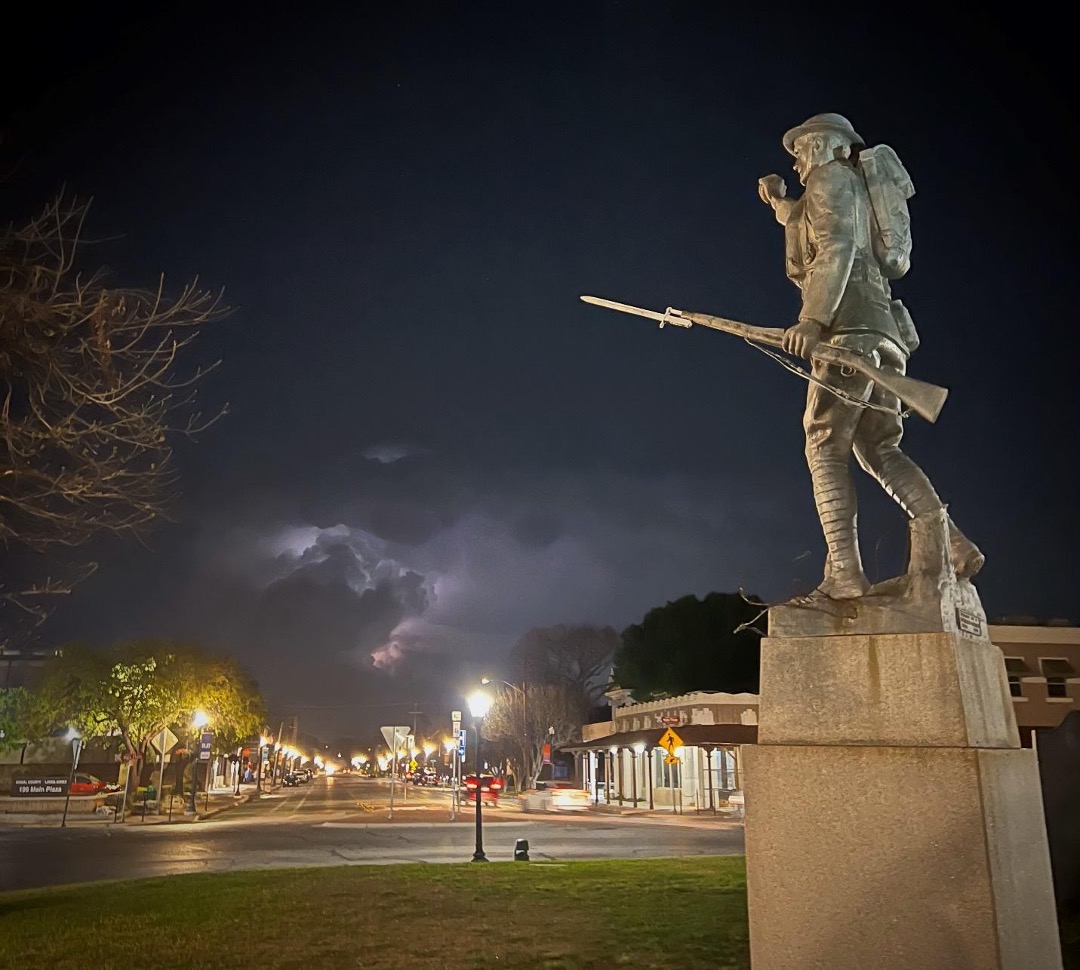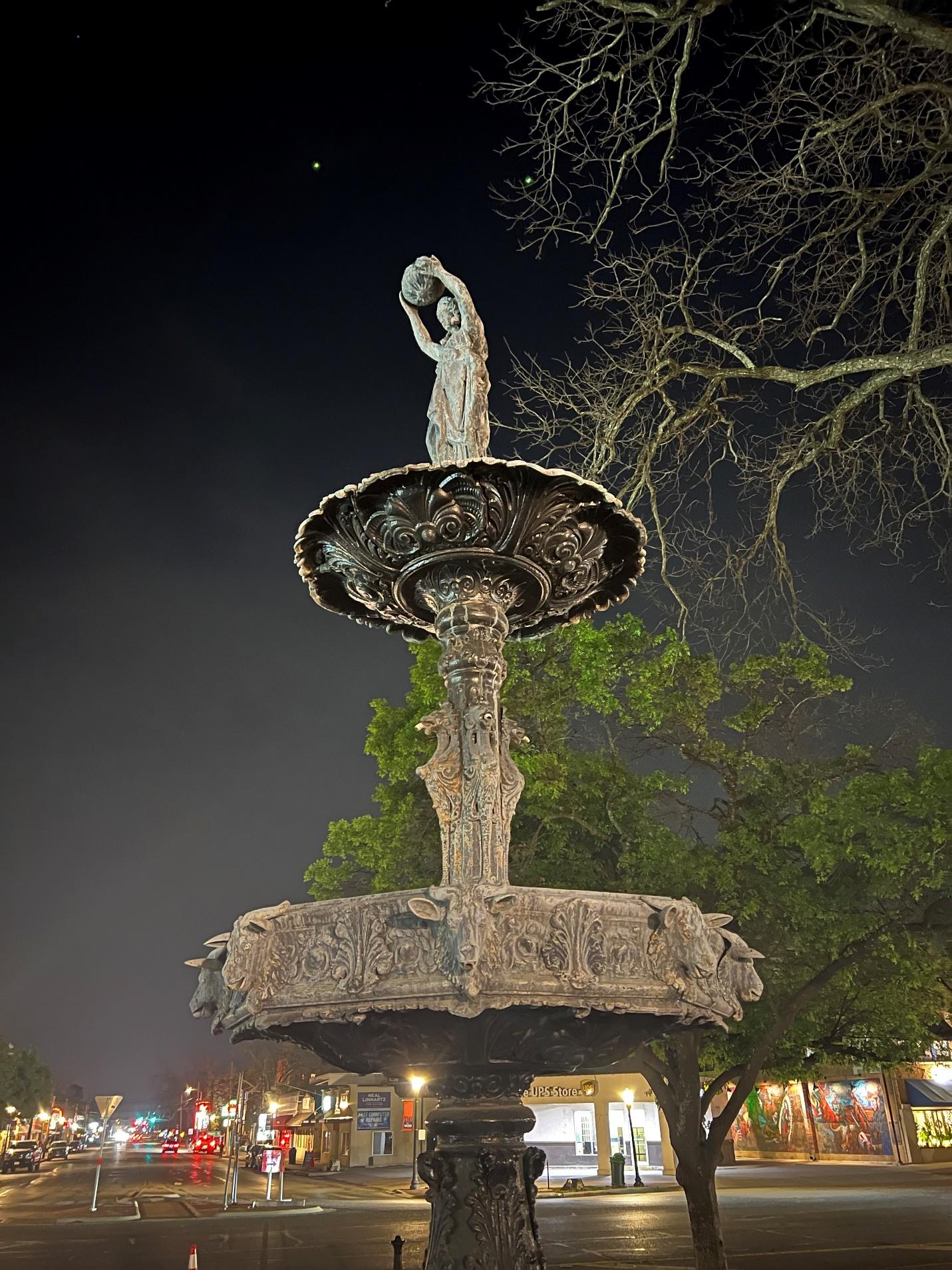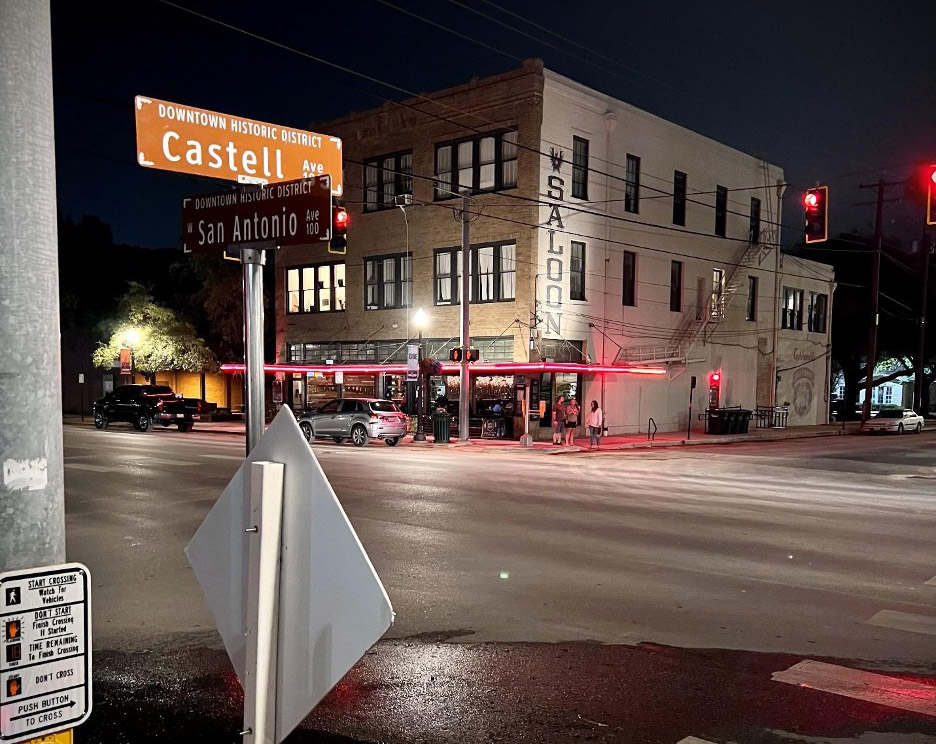
New Braunfels’ Main Plaza, with a lightning storm over Austin in the distance. Photo by Vanessa Hartman
Just as we were leaving the restaurant on the outskirts of New Braunfels, we saw a black sky turn purple and flash with thunderbolts. There was a storm over Austin. We decided to stay and sit in the car for a while to watch the light show. Bolts crackled and arced with agitation, zapping opposing thunderheads.
It was late, but it was spring break and I wanted to go back into town and continue our tour of New Braunfels–on foot. No one in the car said a word. Not my wife and not my 15-year-old son, who was resting his head against the backseat window. We had already put in 2 miles hiking Panther Canyon before we ate. They thought we were done for the night. But, as we soon discovered, the longer you stay in this Hill Country town best known for Schlitterbahn, Gruene Hall, and Wurstfest, the more it casts a spell over you.
Earlier that day, we arrived at our first destination, Landa Park, having driven the hour or so it takes from Austin. Barefoot children splashed in the wading pool and wood ducks paddled to and fro in the pond while dunking their beaks in the water. Leafless cypress trees towered above us while blue skies made way for gray clouds rolling in.
After walking around the grounds of the park for 20 minutes, we headed back to the car to grab our CamelBak and hiking gear. A shirtless young man with a handlebar mustache riding an odd machine glided past us. I stopped him and asked about his contraption. He spun around on his Onewheel, an electric skateboard that travels on just one go-kart-size wheel. He was cruising the park with his two Australian shepherds. Their glowing eyes looked like marbles with blue and gray swirls inside. They circled around him, panting, waiting to go.
Suited up, we crossed the street. As I walked by the famous Comal Springs on California Boulevard, I noticed it was dry—usually a sign of an over-pumped aquifer and drought. We took the first offshoot trail we saw just after the trailhead. It took us up to the top of the hillside, where we encountered yellow spring bees swarming blue-curls.
Suddenly, my son, who had run up ahead, turned around and was waving his hands frantically. Quickly heading back down to us, he whisper-shouted that we needed to go back. He heard an unwelcoming hiss in the bush. Maybe a bobcat, he guessed. Right at that moment, a vulture launched up out of the brush right by us, beating its great black ash wings, perching itself on a dead tree. The vulture adjusted its grasp on the branch. We realized it was guarding something dead below.
Catching our breath, we continued up to an overlook of Panther Canyon. Off in the distance was the old Comal/Lower Colorado River Authority power plant. Built in 1926, it once powered the town of New Braunfels and San Antonio but closed in 1973. It has since been converted to residential lofts.
Our plan was to go downtown after our hike and follow a route I picked out from a 20-year-old walking tour guidebook I own, but my wife suggested we have dinner first. So off we went to Lazy J Cajun restaurant, about 8 miles from the main square, where we enjoyed a tray of fresh crawfish, alligator po’boys, and ice-cold drinks. This is when the lightning storm ramped up as we headed back to our car and I “convinced” my family to go back into town.
As we made our way to the downtown Main Plaza, we were halted by a long train cutting across the night. Under a flashing sky, it felt like we were in a play, onstage, under the red lights of the boom gate with an audience all around us that we couldn’t see.
At San Antonio Street, we parked by the courthouse and got out to stretch our legs. Walking around, I started reading a marker about the construction of the courthouse, which dates to 1898, as the winds picked up. The American flag on the courthouse roof popped, rattling the chain on the flagpole. I still couldn’t believe a cold front was coming through. Wasn’t it spring break?
On our way to the historic Main Plaza—passing a police car parked by the curb with its engine running and no silhouette behind the glass, just a dash with red and orange lights on inside—we came upon a black, cast-iron fountain decorated with dragons and goats’ heads. There was no water running. If I were to ever dream up a fountain made by a secret society, it would look exactly like this. Looking beyond the World War I monument in the plaza, we could see the storm rage far off in the distance.

The fountain located in Main Plaza. Photo by Bobby Alemán
My map had us going down Seguin Street to Coll and back. Groups of young women walked past us, chatting and giggling, on their way to a bar. The headlights of cars closed in on us where we stood on the crosswalk and quickly joined the turnaround. Down the street, I could see a red, square neon sign beckoning us to our next destination.
We passed 155-year-old Naegelin’s Bakery, the oldest bakery in Texas, and walked past shop after shop until we made it to the Faust Hotel. In need of a bathroom break, we pulled on the brass handle. A woman smoking out front in the terrace garden put out her cigarette and followed us in.
The white-walled lobby had furniture made of old wood, all the trims of which seemed painted in gold. On one wall hung a portrait of Prince Carl of Solms-Braunfels, the founder of New Braunfels, conveying an aristocratic air with his handlebar mustache and helmet under his arm.
Taylor Foeller, the front desk clerk, gave us a short history and leaned in closer to share that it was reportedly haunted. She took us to the ballroom—but didn’t turn on the lights. All we could see was a mirror on a wall and an old-world décor with diaphanous curtains and white pillars on very old carpet. My chest felt tight, like it was being squeezed. My wife agreed. “The air is heavy,” she said.
Feeling abundantly spooked by now, we went back to the front desk, where Foeller told us about other places with unexplained activity. She said people think a “ghost cat” haunts the third floor. There have been reports of scratching at doors and meowing in the hallway. She even told us that she’s heard accounts of something that jumps onto beds and curls itself at your feet. All I could do was laugh. A ghost cat? I’ve never heard of that before. But maybe a cat owner would know.
Right as the conversation was heating up, two guests came in and asked for assistance. This was our cue to leave, but before we did, Foeller told us that of all the haunted places in New Braunfels, the most haunted was a floor above the Phoenix Saloon. She showed us to the back door and to the street that led right there.
By coincidence, for a story about Longhorn Cavern, I interviewed an 82-year-old lady who told me her grandfather was once a co-owner of the Phoenix, and also a bootlegger. She said there were underground tunnels to the bar across the street from the Phoenix. She also said her grandfather’s brother died nearby, on Seguin Street, in a duel over a woman.
We walked up to the building and could hear live music inside. Red lights glowed everywhere. But I was totally fine where I was–standing outside. I had no desire to go inside.

According to the Faust Hotel’s front desk clerk, the Phoenix Saloon is the most haunted place in New Braunfels. Photo by Bobby Alemán
I couldn’t believe I was dragging my family by a bar in an unfamiliar town at 10:30 at night. We could hear diesel pickup trucks all over town peeling off at stop lights. It sounded like a tractor pull and reminded me of life back home on the South Texas Plains.
We briefly stopped by the New Braunfels Fire Museum, located inside the city’s first fire station. The museum was closed, but on tiptoe we looked in the windows and saw a garage filled with antique fire trucks.
From there, we trudged uphill on Academy Street back to Coll, where we found the Sophienburg Museum. This is the site Prince Carl of Solms-Braunfels chose for a fortress overlooking Germany’s new colony, founded on March 21, 1845. A marker for Hermann Seele, the first schoolteacher in New Braunfels, was up closer to the building. Seele wrote about life in Texas and served as a lawyer, mayor, postmaster, and legislator. He is considered the “Soul of New Braunfels.”
By now, it was 11 o’clock and time to head home. We made the long walk back to the courthouse and drove in a rainstorm as fierce winds tugged on our car on Interstate 35. My son and wife were beat, so I told them, “You’ll never remember how tired you were, you’ll only remember the good parts.”
A few days later, I looked up the origins for the name of Panther Canyon. I found an article in the local newspaper, the New Braunfels Herald-Zeitung, by Keva Boardman, who is also the curator of the Sophienburg Museum. In the article, she shared a story written by Hermann Seele from 1853.
According to legend, a woman, “Maria Z.,” encounters a panther near Comal Springs. The panther is moaning, writhing in pain, because it cannot close its jaws. A bone is lodged in its mouth. The woman builds up the nerve to help it and removes the bone by taking a piece of wood and a stone to knock it out of its mouth. The panther weakly gets on its feet and walks to the spring and lowers its head to drink. Maria immediately runs off to a cabin nearby and faints when she arrives at the door. Residents rush to look for the creature by the springs. They find the bone and the panther’s tracks. They follow the tracks up to the top of the hillside, but the panther is never found.
I paused for a moment and a thought crossed my mind. I chuckled. Perhaps the canyon panther is the Faust Hotel ghost cat—the very cat whose tracks we were following all day.








